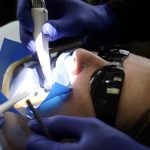
The Importance of Precision in Dental Surgery
February 22, 2025
Today, There is a Bright Future for Dental Equipment
February 22, 2025Introduction
Dentistry is a field in medicine where precision, dexterity, and manual skills prevail. Because of the nature of their work, dentists spend long hours in certain static physical positions, ultimately resulting in wear and tear on their hands, wrists, and the rest of the body. Serious injuries may include muscle strains, joint disorders, and chronic problems in hands and other parts of the body.
This is where ergonomics plays a huge role. Ergonomics with respect to dentistry therefore concerns the design of place and tools such that it minimizes physical stress and strain on the dentist. Doing so improves their comfort, but also lowers risks for severe injuries, all of which help to improve performance and productivity.
In this article, we are going to look into the importance of ergonomics in dentistry and how state-of-the-art ergonomic tools and techniques help reduce hand strain and injury in dentists.
Ergonomics and its Importance in Dentistry
Ergonomics is the science of creating work environments and tasks in keeping with the capabilities and limitations of the workers. It means designing and using better tools in dentistry, adjusting the dental chair and the workspace, and adopting the right techniques to minimize the physical fatigue on the arms and body.
Dentists are continuously exposed to working in nooks and crannies in very particular postures for long periods. This leads to considerable physical stress on neck, shoulders, back, and hands. These long periods of postures without ergonomic practices may lead to a lot of conditions such as the carpal tunnel syndrome, tendonitis, neck and back pains, and joint problems. Therefore, proper ergonomics in dentistry is not only health enhancing but also an attempt to increase the career spans of the dentists by reducing injury risks.
Ergonomics Effects on Decreasing Strain and Injury in Dentistry
Keeping Away Posture Influence and Musculoskeletal Problems from Risk
Dentists are usually found to be bent over very uncomfortable postures for hours together while performing surgery or treatment. Over the time, these positions put severe tension on joints and muscles at the neck, shoulders, and back. The severity of the strain can be alleviated through ergonomic dental chairs as they help position patients in an angle, height, and location most suitable and most conducive to good body alignment. The result allows dentists to maintain a more comfortable posture while accessing the patient without unnecessarily stressing their bodies.
Ergonomic Tools for Hand and Wrist Strain Reduction
Dentists must work precision tools for treatments, but lack of proper equipment can contribute to hand and wrist strain. Common ergonomic design features in dental instruments entail easy holding, lightweight and comfortable use (hence less pressure on hands). Such instruments allow smooth performance of procedures even during long hours and with little fatigue in hands.
Advanced Dental Equipment for Minimal Strain
Advanced dental equipment also has a strong role to play concerning ergonomics in the working environment. Ergonomically designed dental units allow for easy adjustment, where the position of the patient can be changed without the dentist straining physically. Also, tools such as laser shun move-up hands and thus are less prone to repetitive strain injury when using manual instruments.
The Advantages of Ergonomics in Dentistry
Pain and Discomfort Minimization
One of the major benefits of ergonomics for dentists is reducing pain and discomfort. Using ergonomic chairs, tools, and workstations, the dentists are more comfortable working throughout the day without the stress and strain of long periods of poor body posture and overhead hand movements.
Increased productivity and efficiency
The dentist can keep on with his work more hours without any fatigue or discomfort with ergonomic equipment. Subsequently, this reduction in discomfort and increase in comfort leads to improved efficacy thereby resulting to higher productivity, since they can accomplish their tasks more efficiently and with fewer mistakes. This benefit ultimately trickles down to patients as they enjoy better care and more attention to detail.
Medical Treatment Reduction
Work-related injuries in the practice of dentistry can involve costly medical expenses consisting of medicines, physiotherapy, surgical procedures, hospitalization, etc. By adhering to ergonomic practices, dentists could minimize the possibility of developing such conditions requiring medical attention. Thus, they can save on the medical bills as well as continue working instead of recovering for extended periods.
How X-Forceps Can Be Significant in Alleviating Hand Stress during Dentistry Practices
Ergonomics is always important in dentistry when it comes to hand strain and injuries, such as when using X-Forceps, which boasts consideration for the dentist’s comfort. In fact, this is a tool that augments hand strength and reduces fatigue when used on patients. The ergonomic design also makes the positioning more comfortable, with better control and fewer awkward postures, thus minimizing chances of chronic long-term injuries to the hands. Also, the incorporation of advance technology: pressure sensors and cameras precisely ensure movements as voiding of unnecessary works. All created for the comfortability of the dentist while working, ultimately improves both the wellbeing as well patient care.
The ergonomics act as a significant factor in dentistry while reducing hand strain and injury. X-Forceps has actually been designed keeping in view the comforts of the dentist. It is a tool that improves hand strength and reduces fatigue while using it with patients. Ergonomically it allows much better control and lesser awkward positions, thereby preventing long-term injury of hands. Moreover, advanced technologies like pressure sensors and cameras have been integrated into the system to ensure proper movements while reducing the unnecessary effort.
All these improvements were made for the comfortability of a dentist during work, which eventually leads to better well-being and, thus, also ensures efficient patient care.
Conclusion
Ergonomics in dentistry is not only about comfort for a dentist, but it also concerns the care rendered and how it translates to the patient’s experience. With the ergonomically designed tools and work environment, it is possible for dentists to limit their physical conditions that could pose risks of injuries and would allow him or her to prolong the career in practice, while also improving patient care.
The integration of ergonomics into the practice of dentistry is imperative to the health of the dentist and successful practice.

